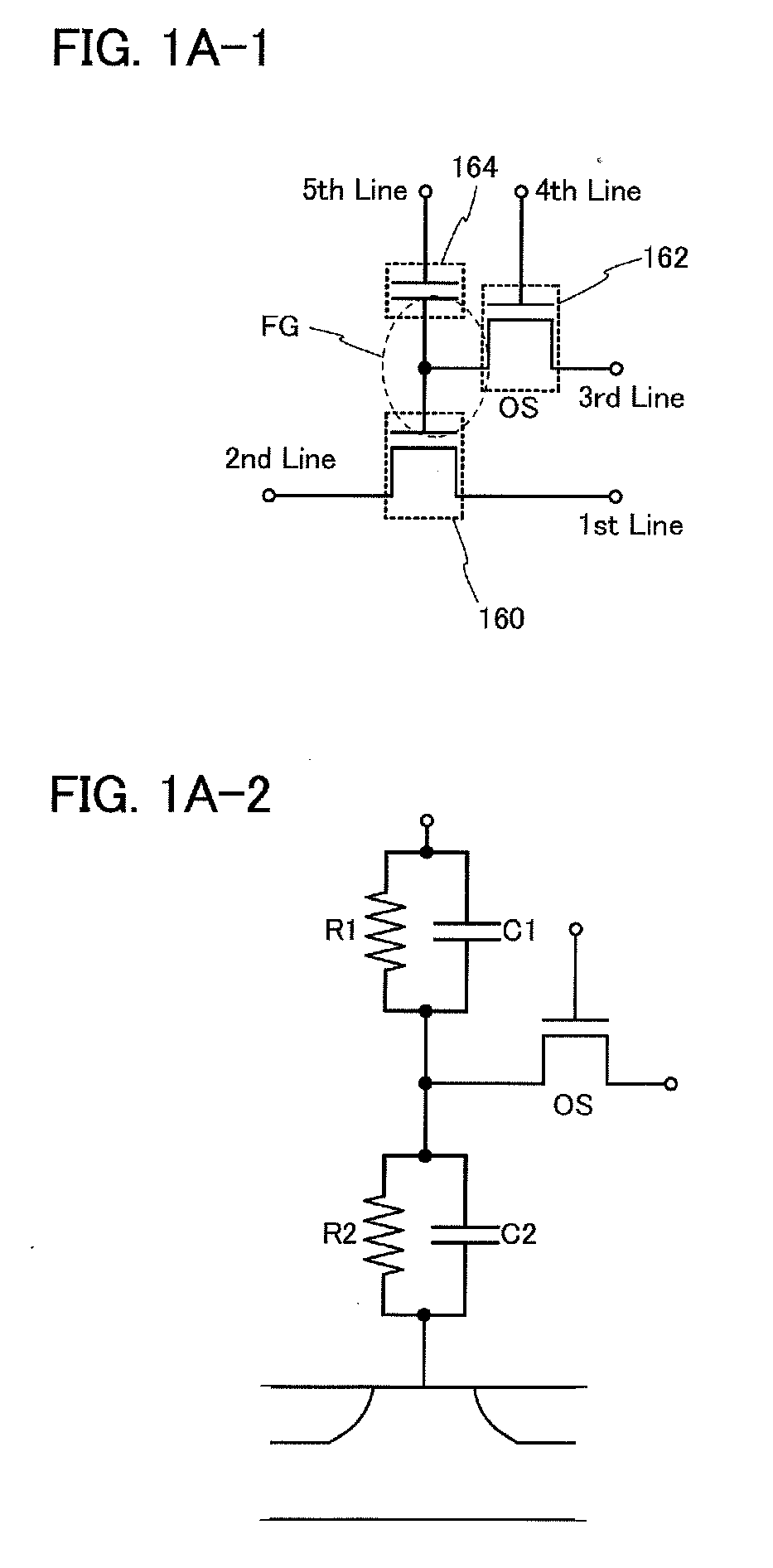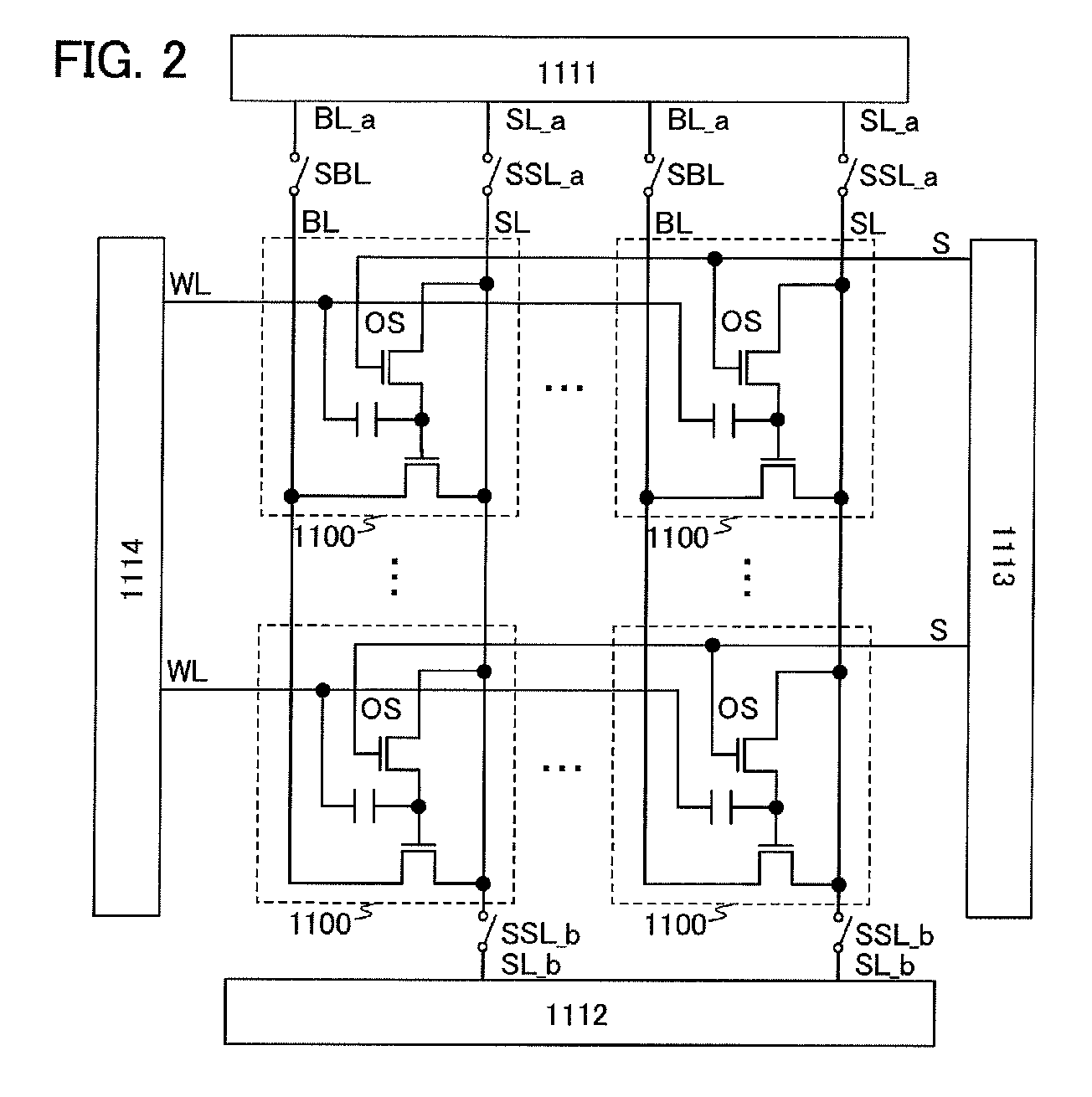Semiconductor device
a technology of semiconductors and semiconductors, applied in the direction of capacitors, solid-state devices, instruments, etc., can solve the problems of increased cost per storage capacity, loss of stored data in srams, and difficulty in sufficiently reducing power consumption, so as to achieve the effect of reducing power consumption, ensuring data retention, and ensuring data retention
- Summary
- Abstract
- Description
- Claims
- Application Information
AI Technical Summary
Benefits of technology
Problems solved by technology
Method used
Image
Examples
embodiment 1
[0059]In this embodiment, a circuit configuration and operation of a semiconductor device according to one embodiment of the disclosed invention will be described with reference to FIGS. 1A-1 and 1A-2. Note that in each of circuit diagrams, “OS” may be written beside a transistor in order to indicate that the transistor includes an oxide semiconductor.
[0060]In the semiconductor device illustrated in FIG. 1A-1, a first wiring (a 1st Line) is electrically connected to a source electrode of a transistor 160, and a second wiring (a 2nd Line) is electrically connected to a drain electrode of the transistor 160. A gate electrode of the transistor 160 and one of a source electrode and a drain electrode of a transistor 162 are electrically connected to one of electrodes of a capacitor 164. A third wiring (a 3rd Line) is electrically connected to the other of the source electrode and the drain electrode of the transistor 162, and a fourth wiring (a 4th Line) is electrically connected to a ga...
embodiment 2
[0096]In this embodiment, an application example of the semiconductor device described in the above embodiment will be described. Specifically, an example of a semiconductor device in which the semiconductor devices described in the above embodiment are arranged in matrix will be described.
[0097]FIG. 2 is an example of a circuit diagram of a semiconductor device including memory capacity of m×n bits.
[0098]The semiconductor device according to one embodiment of the present invention includes a memory cell array where m word lines WL, m signal lines S, n bit lines BL, n source lines SL and a plurality of memory cells 1100 arranged in matrix of m (rows) (in a vertical direction)×n (columns) (in a horizontal direction) (m and n are natural numbers), and peripheral circuits of a first driver circuit 1111, a second driver circuit 1112, a third driver circuit 1113, and a fourth driver circuit 1114. Here, the structure described in the foregoing embodiment (the structure illustrated in FIG....
embodiment 3
[0125]In this embodiment, another example of a semiconductor device in which the semiconductor devices described in the above embodiments are arranged in matrix will be described.
[0126]FIG. 6 is an example of a circuit diagram of a semiconductor device including memory capacity of m×n bits.
[0127]The semiconductor device according to one embodiment of the present invention includes a memory cell array where m word lines WL, m signal lines S, n bit lines BL, n2 source lines SL, and a plurality of memory cells 1200 arranged in matrix of m (rows) (in a vertical direction)×n (columns) (in a horizontal direction) and peripheral circuits of a first driver circuit 1211, a second driver circuit 1212, a third driver circuit 1213, and a fourth driver circuit 1214 (m, n, and n2 are natural numbers and n2 is the smallest natural number which is greater than or equal to n / 2). Here, the structure described in the foregoing embodiment (the structure illustrated in FIG. 1A-1) is applied to the memor...
PUM
 Login to View More
Login to View More Abstract
Description
Claims
Application Information
 Login to View More
Login to View More - R&D
- Intellectual Property
- Life Sciences
- Materials
- Tech Scout
- Unparalleled Data Quality
- Higher Quality Content
- 60% Fewer Hallucinations
Browse by: Latest US Patents, China's latest patents, Technical Efficacy Thesaurus, Application Domain, Technology Topic, Popular Technical Reports.
© 2025 PatSnap. All rights reserved.Legal|Privacy policy|Modern Slavery Act Transparency Statement|Sitemap|About US| Contact US: help@patsnap.com



